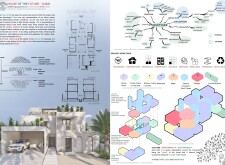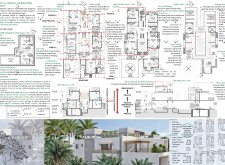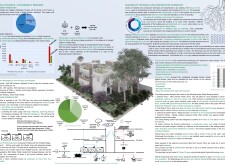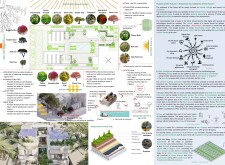5 key facts about this project
## Project Overview
The "House of the Future" is an architectural design initiative located in Dubai, specifically tailored for the Emirati context. The intent is to innovate residential spaces, responding to the challenges posed by climate change while promoting sustainable living practices. This design melds traditional Emirati cultural values with contemporary technology and emphasizes resilience, comfort, and eco-friendly features.
### Spatial Organization
The site plan exhibits a well-defined arrangement of private, semi-private, and public spaces. The ground floor features major communal areas, including a family dining room and living spaces, which are designed to foster inclusivity. The kitchen serves as a multifunctional area for both cooking and social interaction. On the first floor, private sleeping quarters ensure a peaceful environment, while the lower ground floor accommodates essential utilities to enhance operational efficiency. Internal courtyards provide natural ventilation and lighting, integral to adapting to Dubai's climate, and are complemented by strategically placed landscaping that enhances the connection between the structure and its surroundings.
### Materiality and Sustainability
Key materials selected for the project support its sustainability objectives. Graphene, recognized for its strength and lightweight properties, reinforces the structural integrity of key components. Sustainable timber sourced from responsibly managed forests contributes to the home's ecological framework. Additionally, straw bales in wall construction offer superior thermal performance with minimal environmental impact. Water management systems, such as rainwater harvesting tanks, support self-sustenance, while photovoltaic panels and wind turbines empower the residence with renewable energy sources. Each material is carefully chosen to minimize energy consumption, enhance occupant comfort, and promote long-term sustainability.
Strategic design choices also include intelligent living spaces equipped with AI and IoT technologies that monitor energy and water usage, enabling real-time adjustments for efficiency. Dynamic shading elements such as adjustable sails and green roofs adapt to seasonal changes, maintaining a comfortable indoor climate. Landscaping integrates native plants that require minimal water, reinforcing the commitment to local ecology and environmental responsibility.






















































